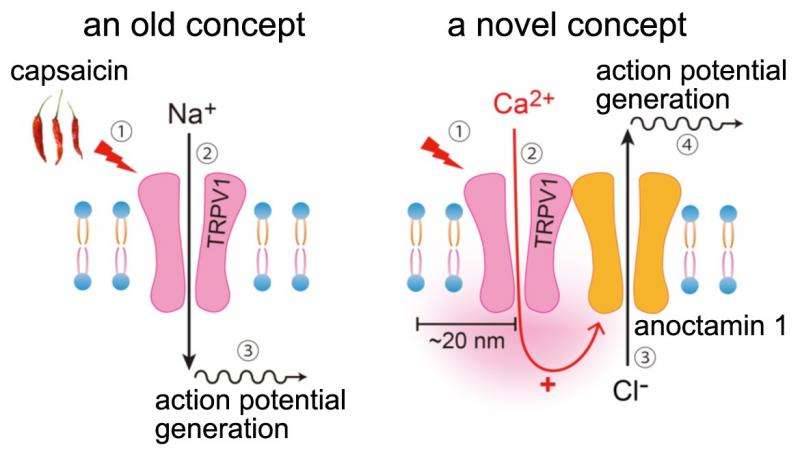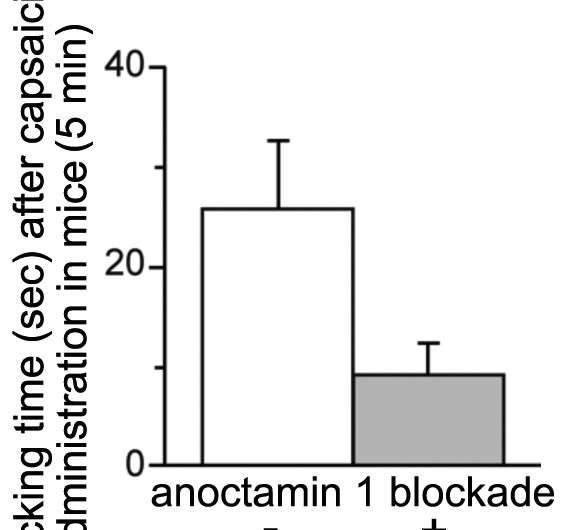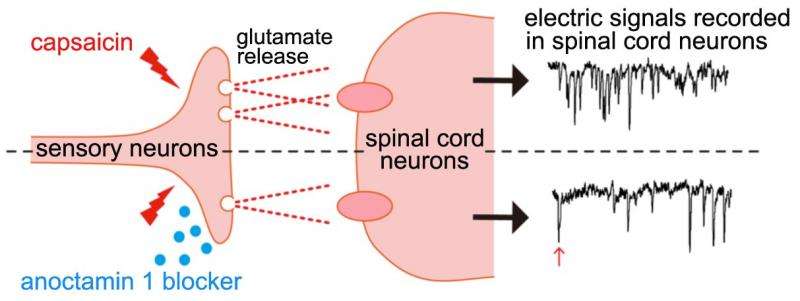Enhancing mechanism of capsaicin-evoked pain sensation

Drs. Takayama and Tominaga in National Institute for Physiological Sciences (NIPS) (Okazaki Institute for Integrative Bioscience) clarified that an interaction between capsaicin receptor TRPV1 and chloride channel anoctamin 1 causes enhancement of the capsaicin-evoked pain sensation in mice in collaboration with Dr. Uta (Toyama University) and Dr. Furue (NIPS). This result will be published in the Proceedings of the National Academy of Sciences of the United States of America.
It has been well known for more than 10 years that capsaicin contained in capsicums causes pungent (pain) sensation through activation of capsaicin receptor TRPV1 expressed in sensory neurons. Anoctamin 1 is also known to be involved in nociception independent of TRPV1. Drs. Takayama and Tominaga found that nociceptive responses are increased by anoctamin 1 activated by TRPV1 which binds to anoctamin 1 in the analyses using sensory neurons and spinal cord of mice. In addition, they proved that chemical blockade of anoctamin 1 is effective for relief of pain induced by TRPV1 activation.
The research group focused on the two ion channel proteins, TRPV1 and anoctamin 1 in mouse sensory neurons. And, they found that anoctamin 1 activation is accompanied by TRPV1 activity and that this sequential channel activation enhances capsaicin-evoked pain sensation.
Capsaicin-evoked burning pain sensation is induced by neural excitation through activation of TRPV1 in sensory neurons. While hot water activates TRPV1, capsaicin is stronger stimulus for TRPV1. Because TRPV1 is a non-selective cation channel, people believed that Na+ ion influx through TRPV1 pore causes depolarization, leading to the action potential generation (Figure 1, left). In this study, however, the research found a novel pain-enhancing mechanism in which anotamin 1 activated by Ca2+ ions entering cells through TRPV1 causes chloride efflux because intracellular chloride concentrations are high in the sensory neurons, which leads to further depolarization. In addition, the research group found that the functional interaction is based on their physical binding, indicating that Ca2+ ions work in the nanodomain within 20 nm distance (Figure 1, right). Furthermore, the research group observed that pain-related licking behaviors in mouse hind paws given capsaicin were inhibited by an anoctamin 1 blocker (Figure 2). Protein produced in the sensory neuron cell bodies are believed to be transferred not only to the peripheral sensory nerve endings, but also to the presynaptic terminals of the primary afferent neurons. Nociceptive signal transmission from primary afferent neurons to the second neurons in spinal cord was also reduced by anoctamin 1 blockade. Thus, anoctamin 1 blockade is useful to reduce the TRPV1-mediated pain responses.

An old mechanisms (left): 1) capsaicn activates TRPV1, 2) Na+ ions enter sensory neurons through the TRPV1 pore, 3) action potentials are generated (neurons are excited). A novel mechanism (right): capsaicn activates TRPV1, 2) Ca2+ ions enter sensory neurons through the TRPV1 pore, 3) because intracellular chloride concentrations are high in the sensory neurons, chloride ion efflux is induced by anoctamin 1 activated by Ca2+ ions within 20 nm distance from TRPV1 through physical binding of the two proteins, 4) action potentials are generated. Thus, capsaicin-induced inward currents are composed of two components: TRPV1-mediated Na+ influx and anon efflux through anotamin 1 activated by Ca2+ ions entering cells through TRPV1.

Mice keep licking their hind paws upon capsaicin injection. Time spent for licking for 5 min was reduced by concomitant application of an anoctamin1 blocker.
Nociceptive signals are transmitted from the primary afferent neurons to the second neurons in spinal cord with a neurotransmitter glutamate. The electric signals can be observed (a red arrow). Capsaicin increases such electric signals. However, the increase was reduced by an anoctamin 1 blocker.
More information: Pain-enhancing mechanism through interaction between TRPV1 and anoctamin 1 in sensory neurons, PNAS, www.pnas.org/cgi/doi/10.1073/pnas.1421507112


















